Phone:
720-399-3335
Office address:
1685 S. Colorado Blvd. Suite 151, Denver, CO 80222

While you might view asbestos as a relic of the past, it’s still widely used across several industries. You’re about to start on a journey through the domain of this ‘miracle mineral’, exploring ten different types and their applications.
From building insulation to fireproofing and even automotive industry uses, asbestos’s versatility might surprise you. However, it’s not all rosy; there’s a darker side to this tale that’s equally important to understand.
Are you ready to unravel this complex narrative?
Key Takeaways
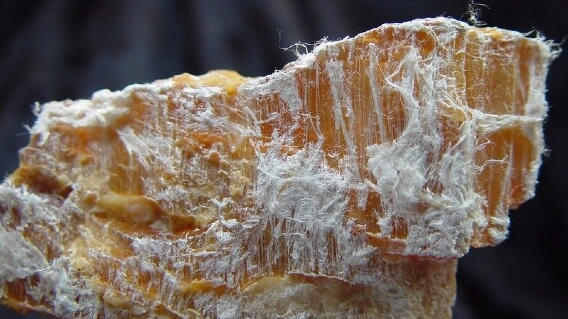
Delving into the world of asbestos materials, you’ll find Chrysotile Asbestos, a type widely used due to its unique properties and applications. Mainly used in building insulation, roof shingles, and automobile brake linings, its flexibility and resistance to heat make it highly desirable.
But it’s not all rosy. The Chrysotile mining impact is considerable. Mining this asbestos type notably disturbs the earth’s surface, leading to soil erosion, habitat destruction, and water pollution. The dust produced during extraction poses severe health risks, like asbestos-related lung diseases.
Chrysotile regulation policies have been implemented worldwide to minimize these impacts. They stipulate strict control measures, like dust suppression techniques and proper waste disposal. Workers’ health is monitored, and exposure limits are set to protect them. However, enforcement of these policies varies globally, with some countries struggling to maintain standards due to lack of resources or corruption.
Understanding Chrysotile Asbestos isn’t just about appreciating its uses. It’s also about acknowledging its environmental and health impacts, and the important role of regulation policies in mitigating them. Chrysotile’s story serves as a reminder that every material we use comes with its own set of challenges that need careful management.
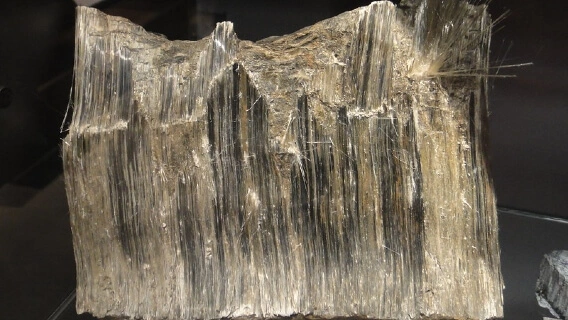
Turning our focus to Amosite Asbestos, you’ll find it’s another widely used type that presents its own unique set of properties, uses, and challenges. This brown asbestos, sourced mainly from South Africa, is notable for its high iron content. Its strength and heat resistance have made it an attractive choice for construction materials, specifically insulation boards and ceiling tiles.
However, acknowledging the Amosite mining impacts is essential. Extensive mining of this material has led to significant environmental degradation, including soil erosion and water pollution. The strong fibers of Amosite, while useful in construction, make it particularly dangerous when inhaled.
The health implications of Amosite are alarming. It’s more hazardous than many other types of asbestos due to its long, sharp fibers which can penetrate deep into lung tissue. Exposure can lead to severe health conditions such as asbestosis, lung cancer, and mesothelioma. So, while Amosite’s properties may seem beneficial on a material level, it’s important to take into account the vast health and environmental repercussions involved in its usage.
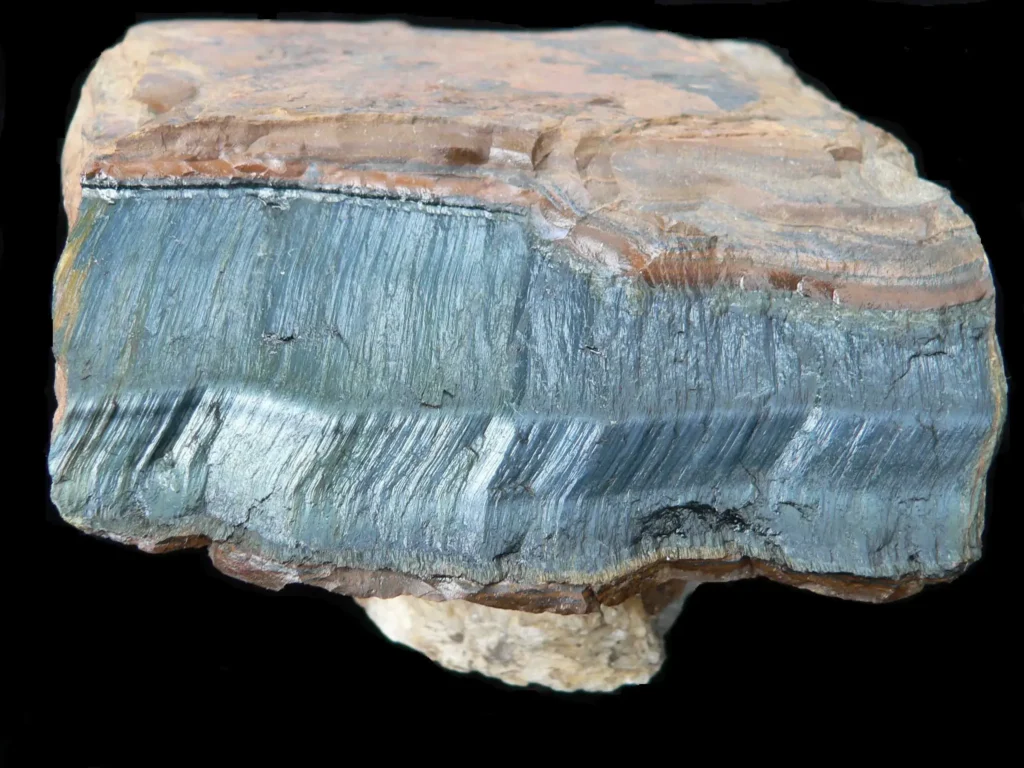
Shifting gears, let’s explore Crocidolite Asbestos, often referred to as blue asbestos, and its notable applications in various industries. This asbestos variety, mined primarily in Australia, South Africa, and Bolivia, featured prominently in insulation products due to its high resistance to heat and electricity.
Mining techniques for Crocidolite involve careful extraction to avoid releasing harmful fibers. It’s a meticulous process, but necessary to limit Crocidolite hazards. Once extracted, it’s mixed with cement or woven into fabrics, making it a versatile material.
However, you must understand the Crocidolite hazards associated with its use. It’s considered the most hazardous asbestos type due to the thin, sharp fibers that can easily penetrate lung tissue when inhaled. This leads to serious health risks including mesothelioma and lung cancer.
Despite its dangers, Crocidolite had significant use in the past. It was commonly found in high-temperature insulation, pipe insulation, and spray-on fireproofing. It was also used in cement products, shipbuilding and even in the manufacture of some types of gas masks.
Currently, due to the known hazards, its use has been restricted globally. The focus has shifted to safe removal and disposal, underscoring the importance of understanding not just its applications, but also the significant health risks it poses.
Call Now
You Can Call Us At This Number: 720-399-3335
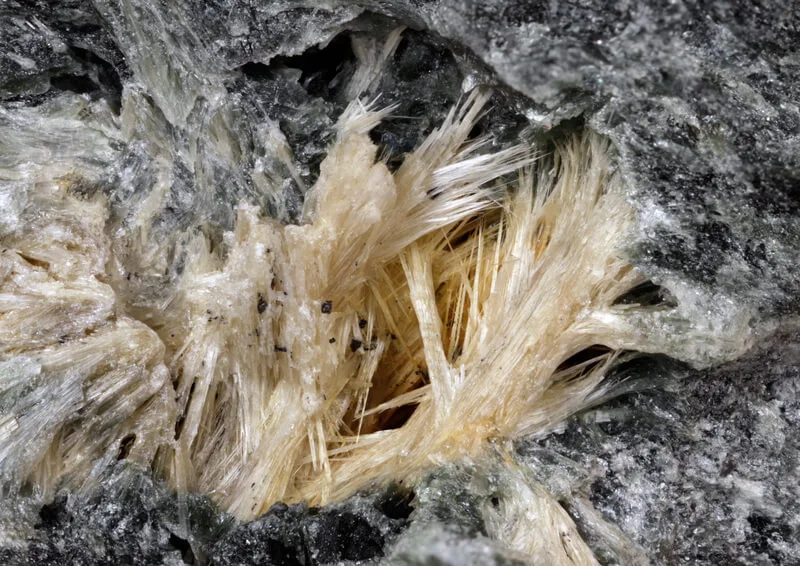
Now, let’s examine the unique characteristics of Tremolite Asbestos, a variant that presents its own set of properties and challenges. One of the six recognized types of asbestos, Tremolite is typically found intermingled with other minerals, making its mineral identification complex yet important. It’s often associated with the metamorphic rocks from which it originates and can be either white, gray, green, or even transparent.
Tremolite’s fibrous nature allows it to be woven into fabrics, increasing its versatility. However, it’s less commonly used commercially due to its high level of toxicity. Tremolite toxicity is very high, even among asbestos types, adding an extra layer of risk to its handling and use.
Microscopically, Tremolite fibers are needle-like and durable. They’re resistant to heat and chemical damage, qualities that made asbestos materials desirable in the first place. However, these same features also make Tremolite especially dangerous, as its fibers can easily be inhaled and lodge into lung tissue, leading to serious health problems.
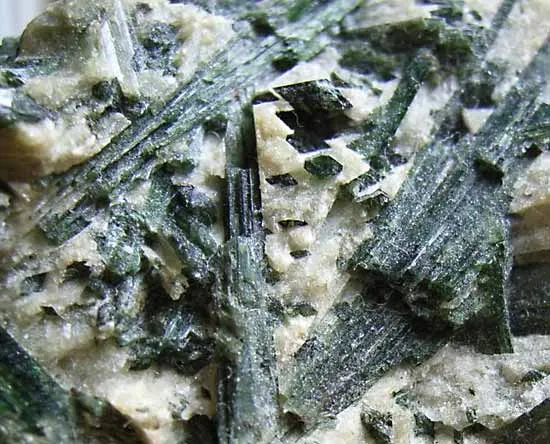
Let’s explore another form of asbestos, specifically Actinolite Asbestos, known for its unique properties and applications. Actinolite, a member of the amphibole asbestos family, is characterized by its dark color and elongated, fibrous structure. Its occurrence is widespread, often found within metamorphic rocks.
While it does have its uses, primarily in construction materials, Actinolite’s toxicity is a major concern. When inhaled, the thin, sharp fibers can pierce your lungs, leading to serious health risks. Studies have linked Actinolite exposure to mesothelioma, a rare yet aggressive form of lung cancer.
So, why has Actinolite been used extensively? Its durability and resistance to heat made it an attractive material for insulation and fireproofing. However, with the increasing awareness of its toxicity, usage has significantly declined in recent years.
Currently, identifying and managing Actinolite’s presence in buildings is a key focus. Specialized teams perform careful removals, ensuring fibers aren’t released into the air. It’s important to remember that the risk lies in inhaling the fibers, not simply being near the material.
As we explore further into asbestos types, it’s clear that understanding each variety’s properties, usage, and associated risks is important.
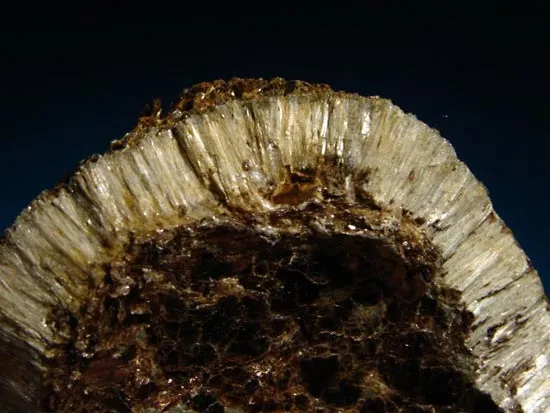
Diving deeper into the world of asbestos, you’ll encounter Anthophyllite, a less common but equally hazardous type, that poses significant risks due to its usage in various industries. It’s been heavily utilized in the construction, automotive, and even the textile industries. Despite its lesser prevalence compared to other asbestos types, the risks associated with Anthophyllite aren’t to be understated.
Anthophyllite mining, though less widespread, has led to serious health consequences for those involved. Like other asbestos minerals, when Anthophyllite fibers become airborne, they can be inhaled or ingested, leading to serious, often fatal, health problems. These include lung cancer, mesothelioma, and asbestosis.
In recent years, asbestos related lawsuits have surged as the dangers of exposure become more widely known. Victims of asbestos exposure, including those who’ve come into contact with Anthophyllite, are seeking compensation for medical costs, loss of earnings, and suffering.
It’s important to recognize the potential risks of Anthophyllite asbestos. While less common, it’s no less dangerous, serving as a stark reminder of the broader dangers posed by asbestos use. As we continue to uncover the extent of asbestos risk, it’s essential to understand each type, including Anthophyllite, and its potential impact.
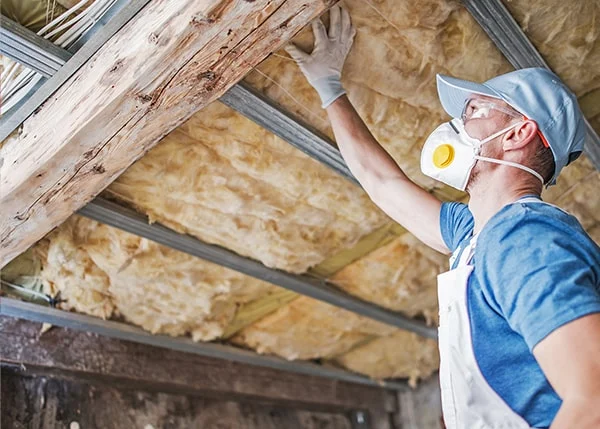
While discussing the dangers of Anthophyllite asbestos, it’s worth noting that asbestos, including this type, has seen frequent use in building insulation, posing a serious risk to both construction workers and residents. Its heat-resistant properties made it an attractive material for insulation in the past. However, the health risks associated with asbestos fibers have led to its disuse in many countries.
Now, you might wonder about safe insulation alternatives. Fiber glass, cellulose, and foam insulation are popular substitutes that pose fewer health risks. These materials have excellent thermal resistance and are safer to handle, install, and live with.
But what if your home already contains asbestos insulation? It’s important to know the right asbestos removal methods to prevent exposure. Remember, asbestos is most dangerous when disturbed. It’s best to hire professionals for its removal. They’re equipped with the proper gear and knowledge to safely remove and dispose of this hazardous material. In doing so, they can guarantee a safe environment for residents and workers alike.
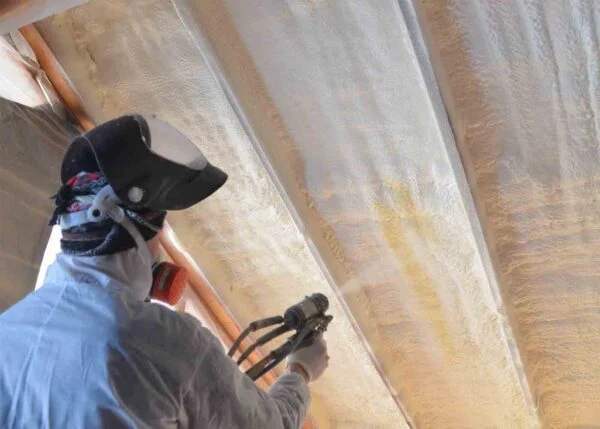
Beyond its use in insulation, asbestos has also been extensively utilized for fireproofing purposes in buildings due to its remarkable heat resistance. This material was commonly sprayed on beams, columns, and ceilings to help prevent the spread of fires.
It’s important for you to understand that despite its effectiveness in fireproofing, the use of asbestos comes with serious health risks. Hence, stringent asbestos safety measures are necessary to protect individuals from its harmful effects.
However, due to the health hazards associated with asbestos, its use in fireproofing has greatly declined. Today, you’ll find that alternative fireproof materials are often used instead, including glass fibers and mineral wool. These materials aren’t only safer but can also offer similar levels of fire resistance as asbestos.
In the past, the benefits of asbestos in fireproofing were unfortunately overshadowed by the serious health risks it posed. Today, safer alternatives are now widely used, providing effective fire resistance without the associated health hazards. It’s important that we continue to prioritize safety and health in our choice of building materials.

Not just in building construction, asbestos has also found its way into the automotive industry, another sector that has greatly benefitted from its heat-resistant properties. Specifically, asbestos was used extensively in brake pad composition. Its ability to withstand high temperatures made it a viable option for use within brake systems to prevent overheating.
The incorporation of asbestos into brake pads wasn’t without its drawbacks, however. The process of manufacturing, installing, and maintaining these brake systems could release asbestos fibers into the environment. This led to a requirement for stringent asbestos disposal methods in an attempt to mitigate the risk of contamination. Asbestos components must be properly sealed and labeled before disposal, and only approved facilities are permitted to handle such materials.
While the use of asbestos in the automotive industry has declined due to the health risks associated with it, it’s worth noting that some older vehicles may still contain asbestos components. As a result, caution is advised when working with or around such vehicles. The automotive industry’s experience with asbestos underscores the material’s complex legacy across various sectors.

Despite its widespread use across industries, asbestos carries a heavy burden of health risks that you need to be aware of. It’s a silent threat, with effects often not manifesting until years after exposure. The chief concern is the development of mesothelioma, a rare and aggressive cancer that primarily affects the lungs and heart.
Mesothelioma diagnosis challenges are extensive as its symptoms often mirror less serious conditions, leading to delayed or misdiagnosis. However, once confirmed, it requires immediate and aggressive treatment, which often has a significant impact on your quality of life.
Asbestos exposure also opens up a Pandora’s box of legal issues. Navigating the asbestos litigation complexities can be overwhelming for most. If you’ve been exposed, you may be entitled to compensation, but proving liability and tracing exposure back to a specific product or workplace is often a convoluted process. It requires a thorough understanding of the legal landscape, and often the help of experienced attorneys.
In this exploration, we’ve delved into ten different types of asbestos materials, from Chrysotile to Actinolite, each significant in the building and automotive industries due to their fireproof properties.
However, their use also poses substantial health risks. As we navigate the complexities of asbestos management, EnvioCore is here to assist. Our expertise ensures that asbestos risks are managed professionally, safeguarding health while complying with regulations.
Understanding these details is crucial to making informed decisions about asbestos use and handling, and EnvioCore is your dedicated partner in this essential safety endeavor.